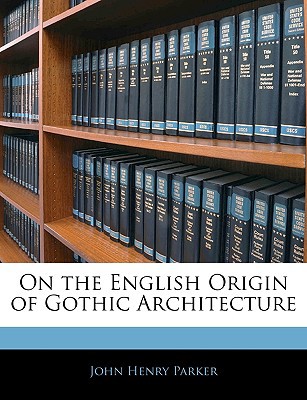

 |

|

The average rating for On the English Origin of Gothic Architecture based on 2 reviews is 4 stars.
Review # 1 was written on 2014-12-14 00:00:00 John Paul Wolforth John Paul WolforthThis book is as they used to say in the sixties a hoot. It is a dazzling display of erudition, insight and laughable drivel. It was in a word everything that I hoped it would be. I read this book because Ruskin was greatly admired by Marcel Proust who considered him to be the greatest authority on aesthetic values of his generation. Such was Proust's admiration for Ruskin that he translated Ruskin's Bible of Amiens into French. I started the Seven Lamps of Architecture expecting a rant on art like one of the many from the Baron de Charlus in A la recherche du temps that is to say an hysterical plea for good taste constituted of wildly absurd pronouncements. That is exactly what I got. I enjoyed it tremendously although I am not quite sure who else would. Let's start with the absurd. Ruskin stated flatly that that good architecture could never employ iron or steel. That would mean that William Jenney, Louis Sullivan, Mies Van der Rohe, John Paxton, Walter Gropius, Eero Saarinen and in fact all of the great modern architects were in fact quite dreadful. Ruskin argued that the Gothic style be made the official style of England and that regulations be put in place to ensure that all building in England conformed to it. He felt that train stations were strictly utilitarian structures and that none of the devices of architecture should be applied to them to enhance their appearance. Ruskin then must have hated Eiffel's Budapest train station, the Gare St. Lazare and the Victoria station. No mechanically created or shaped materials should be used in "architectural" buildings. Beams should be hand cut from timbers. Stones should all be cut individually. It is difficult to imagine greater nonsense that what Ruskin utters on so many instances in the Seven Lamps or Architecture. There is certainly plenty to laugh at in the Seven Lamps of Architecture but as one advances one sees what a great critic Ruskin was. He explains what constitutes good taste and bad taste in architecture with brilliance. Lines and forms must be natural resembling those in nature. No veneers should be applied to disguise the real material. Ornamentation should be discreet. Ruskin demonstrations incredible thoroughness in how he observes buildings. He measures doors and arches to establish the proportions the architect used. He shows that in one cathedral all the four doors at the front entrance had different widths which he argues was meant as a message from the architect that he the architect felt free to disregard the laws of symmetry. The Seven Lamps of Architecture will be a great joy to read for anyone who has visited Venice and several of the great Gothic Cathedrals of England and France. This book is so overtly crazy and so tremendously wise in reality. |
Review # 2 was written on 2008-03-28 00:00:00 Daniel Dimauro Daniel DimauroWhat I learned? The Importance of Being Ornamental. |
CAN'T FIND WHAT YOU'RE LOOKING FOR? CLICK HERE!!!